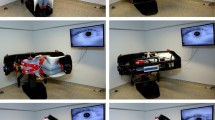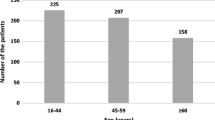Abstract
Residual dizziness (RD) following the resolution of a benign paroxysmal positional vertigo (BBPV) episode is frequently reported by patients. Possible causes are still under debate in the literature. This study discusses the possible role of otolithic function and of elapsed time from onset of symptoms to diagnosis in the genesis of RD. In total, 116 patients younger than 65 years with their first episode of BPPV and without any other comorbidities were enrolled in the study. Before a bedside examination, subjective visual vertical (SVV) was determined in the case of a history suggestive of BPPV. SVV was tested 1 week later in those patients with BPPV of the posterior semicircular canal, and in whom positioning maneuvers showed resolution of BPPV. At 1 week control, reported RD and Dizziness Handicap Inventory (DHI) were recorded. Diagnosis and treatment of BPPV occurred within 4 days in 43 patients (group A), between 5 and 8 days in 38 patients (group B) and in more than 9 days in 35 patients (group C). Higher values of reported RD and DHI were recorded in group C, while higher values of SVV deviation were recorded in group A with an inverse relationship between SVV and DHI. Initial peripheral vestibular function asymmetry due to BPPV can induce a new central adaptation. This adaptation becomes better established the longer otoconia remain floating in the endolymph. Because of these changes, the brain is unable to quickly readapt to the old pattern after resolution resulting in more persistent RD.




Similar content being viewed by others
References
Brandt T, Steddin S (1993) Current view of the mechanisms of benign paroxysmal positioning vertigo: cupulolithiasis or canalolithiasis? J Vestib Res 3:373–382
Epley JM (1992) The canalith repositioning procedure: for treatment of benign paroxysmal positional vertigo. Otolaryngol Head Neck Surg 107:399–404
Semont A, Freyss G, Vitte E (1988) Curing the BPPV with a liberatory maneuver. Adv Otorhinolaryngol 42:290–293
Di Girolamo S, Paludetti G, Briglia G et al (1998) Postural control in benign paroxysmal positional vertigo before and after recovery. Acta Otolaryngol 118:289–293
Lee NH, Kwon HJ, Ban JH (2008) Analysis of residual symptoms after treatment in benign paroxysmal positional vertigo using questionnaire. Otolaryngol Head Neck Surg 14(2):232–236
Di Girolamo S, Ottaviani F, Scarano E, Picciotti P, Di Nardo W (2000) Postural control in horizontal benign paroxysmal positional vertigo. Eur Arch Otorhinolaryngol 257(7):372–375
Giacomini PG, Alessandrini M, Magrini A (2002) Long-term postural abnormalities in benign paroxysmal positional vertigo. ORL J Otorhinolaryngol Relat Spec 64(4):237–241
Von Brevern M, Schmidt T, Schonfeld U, Lempert T, Clarke AH (2005) Utricular dysfunction in patients with benign paroxysmal positional vertigo. Otol Neurotol 27:92–96
Dix MR, Hallpike CS (1952) The pathology, symptomatology and diagnosis of certain common disorders of the vestibular system. Proc Soc Med 45:341–354
Cawthorne TE, Hallpike CS (1957) A study of the clinical features and pathologic changes within the temporal bones, brain stem and cerebellum of an early case of positional nystagmus of the so called benign paroxysmal type. Acta Otolaryngol 48:89–105
Lindsay JR, Hemenway WG (1956) Postural vertigo due to unilateral sudden partial loss of vestibular function. Ann Otol 65:692–708
Seok JI, Lee HM, Yoo JH, Lee DK (2008) Residual dizziness after successful repositioning treatment in patients with benign paroxysmal positional vertigo. J Clin Neurotol 4:107–110
Gresty MA, Bronstein AM, Brandt T et al (1992) Neurology of otolith function: peripheral and central disorders. Brain 115:647–673
Headache Classification Committee of the International Headache Society (2004) The international classification of headache disorders. Cephalalgia 24(Suppl 1):1–60
Zung WWK (1971) A rating instrument for anxiety disorders. Psychosomatics 12:371–379
Faralli M, Ricci G, Molini E et al (2007) Determining subjective visual vertical: dynamic versus static testing. Otol Neurotol 28:1069–1071
Faralli M, Longari F, Ricci G, Ibba MC, Frenguelli A (2009) Influence of extero- and proprioceptive afferents of the plantar surface in determining subjective visual vertical in patients with unilateral vestibular dysfunction. Acta Otorhinolaryngol Ital 29:245–250
Böhmer A, Rickenmann J (1995) The subjective visual vertical as a clinical parameter of vestibular function in peripheral vestibular diseases. J Vestib Res 5:35–45
Jacobson GP, Newman CW (1990) The development of the Dizziness Handicap Inventory. Arch Otolaryngol Head Neck Surg 116(4):424–427
Nola G, Mostardini C, Salvi C, Ercolani AP, Ralli G (2010) Validity of Italian adaptation of the Dizziness Handicap Inventory (DHI) and evaluation of the quality of life in patients with acute dizziness. Acta Otorhinolaryngol Ital 30(4):190
Faralli M, Manzari L, Panichi R, Botti F, Ricci G, Longari F, Pettorossi VE (2011) Subjective visual vertical before and after treatment of BPPV episode. Auris Nasus Larynx 38:307–311
Bremova T, Bayer O, Agrawal Y, Kremmyda O, Brandt T, Teufel J, Strupp M (2013) Ocular VEMPs indicate repositioning of otoconia to the utricle after successful liberatory maneuvers in benign paroxysmal positioning vertigo. Acta Otolaryngol 133(12):1297–1303
Faralli M, Cipriani L, Del Zompo MR, Panichi R, Calzolaro L, Ricci G (2014) Benign paroxysmal positional vertigo and migraine. Analysis of 186 cases. B-ENT 10(2):133–139
Lindsay JR, Hemeneway WG (1956) Postural vertigo due to unilateral sudden partial loss of vestibular function. Ann Otol Rhino Laryngol 65:692–708
Treleaven J (2008) Sensorimotor disturbances in neck disorders affecting postural stability, head and eye movement control. Man Ther 13(1):2–11
Faralli M, Ricci G, Ibba MC, Crognoletti M, Longari F, Frenguelli A (2009) Dizziness in patients with recent episodes of benign paroxysmal positional vertigo: real otolithic dysfunction or mental stress? J Otolaryngol Head Neck Surg 38(3):375–380
Teggi R, Giordano L, Bondi S, Fabiano B, Bussi M (2011) Residual dizziness after successful repositioning maneuvers for idiopathic benign paroxysmal positional vertigo in the elderly. Eur Arch Otorhinolaryngol 268(4):507–511
Gall RM, Ireland DJ, Robertson DD (1999) Subjective visual vertical in patients with benign paroxysmal positional vertigo. J Otolaryngol 28:162–165
Vannucchi P (2003) La verticale e/o orizzontale visiva soggettiva. Acta Otorhinolaryngol Ital 5(Suppl 75):74–79
Pollak L, Davies RA, Luxon LL (2002) Effectiveness of the particle repositioning maneuver in benign paroxysmal positional vertigo with and without additional vestibular pathology. Otol Neurotol 23:79–83
Jung HJ, Koo JW, Kim CS, Kim JS, Song JJ (2013) Anxiolytics reduce residual dizziness after successful canalith repositioning maneuvers in benign paroxysmal positional vertigo. Acta Otolaryngol 27(5):259–263
Kim HA, Lee H (2014) Autonomic dysfunction as a possible cause of residual dizziness after successful treatment in benign paroxysmal positional vertigo. Clin Neurophysiol 125(3):608–614
Teggi R, Quaglieri S, Gatti O, Benazzo M, Bussi M (2013) Residual dizziness after successful repositioning maneuvers for idiopathic benign paroxysmal positional vertigo. ORL J Otorhinolaryngol Relat Spec 75(2):74–81
Author information
Authors and Affiliations
Corresponding author
Ethics declarations
Conflict of interest
The authors declare that they have no conflict of interest.
Financial support
This research received no specific grant from any funding agency, commercial or not-for-profit sectors.
Rights and permissions
About this article
Cite this article
Faralli, M., Lapenna, R., Giommetti, G. et al. Residual dizziness after the first BPPV episode: role of otolithic function and of a delayed diagnosis. Eur Arch Otorhinolaryngol 273, 3157–3165 (2016). https://doi.org/10.1007/s00405-016-3947-z
Received:
Accepted:
Published:
Issue Date:
DOI: https://doi.org/10.1007/s00405-016-3947-z




